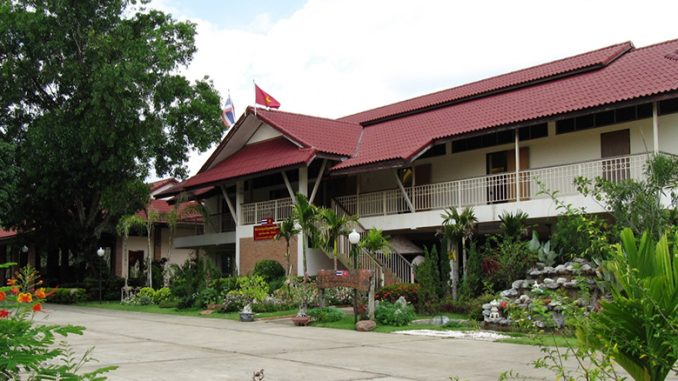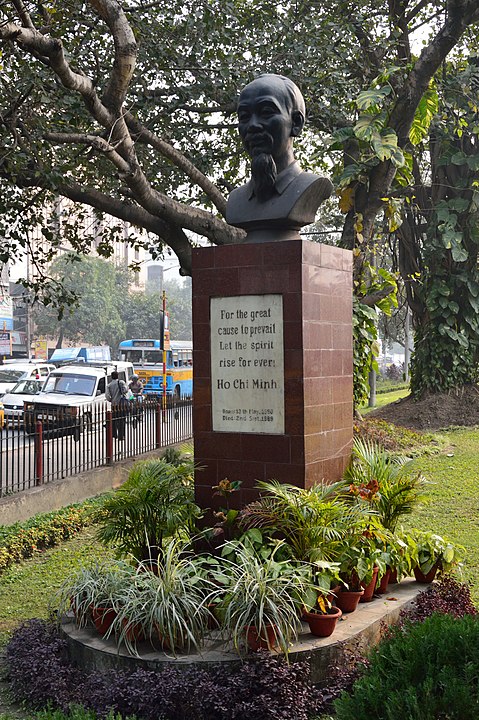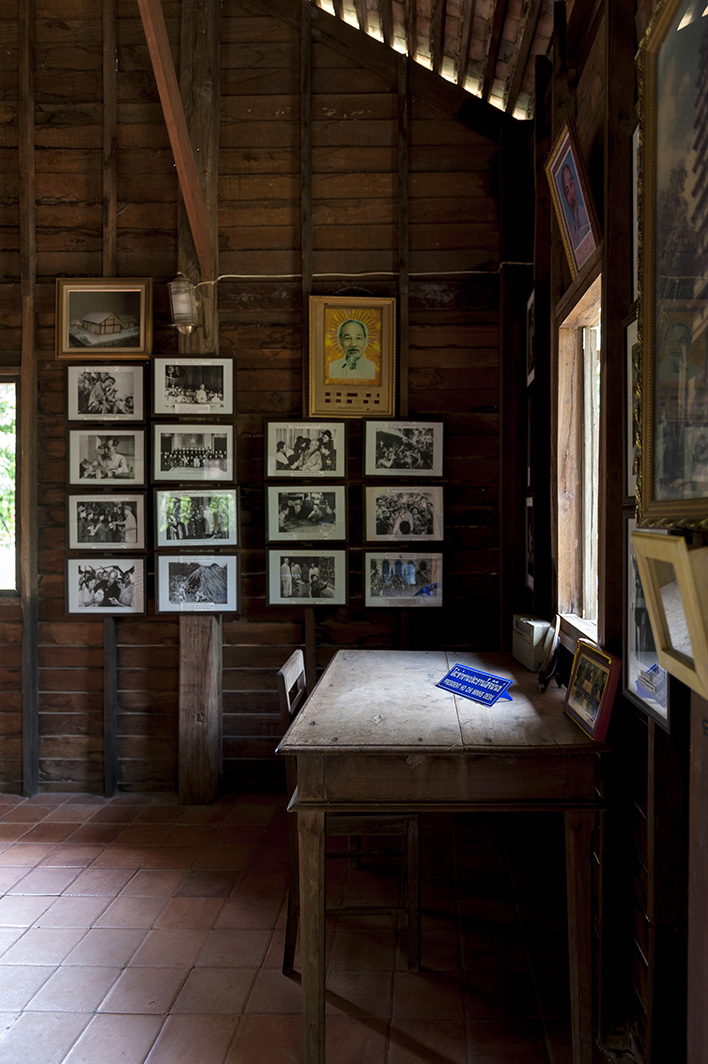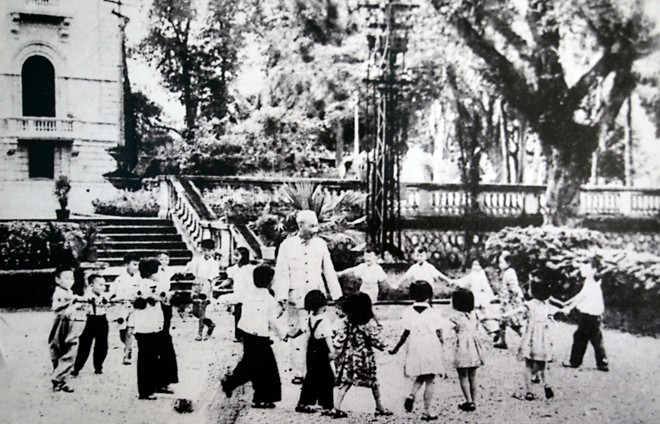
In 1928, Ho Chi Minh arrived in Siam with the goal of expanding revolutionary bases with the help of Vietnamese migrants in the northeast of the country, close to Vietnam but located beyond the reach of French security services. 1 His journeys across this region have become material for commemorative monuments in places where he is believed to have stayed. 2 The Ho Chi Minh Memorial complex (anusorn sathan) in the village of Nachok in Nakhon Phanom, a province on the Lao-Thai border, is one such site. The complex covers an area of 7 rai (slightly over 1 hectare). 3 Visitors go through an imposing archway to enter the place, “designed with an integration of Vietnamese and Thai architecture” and crowned with the Thai and Vietnamese flags. The key attractions of the site are: a life-size statue of a seated Ho Chi Minh “for visitors to pay respect by lighting joss sticks”; a photo gallery; a diorama with wax models of Ho Chi Minh addressing Nachok villagers, and a replica of the Ho Chi Minh House, “a single-storey Vietnamese-style house built entirely of wood” wherein the revolutionary figure supposedly stayed during his sojourn in the village in 1928.

The construction of such an imposing memorial site in honor of Southeast Asia’s most well-known revolutionary leader, in a country that was the United States’ staunch ally during the Cold War and that continues to be strongly anti-communist, may be surprising. However, post-Cold War representations of, and discourses about, Ho Chi Minh – driven in part by the Vietnamese regime – have greatly contributed to the erasure of his communist identity outside Vietnam and in popular culture. In 2004, the then Thai Deputy Prime Minister General Chavalit Yongchaiyudh proclaimed that “President Ho Chi Minh was not only a great leader of the Vietnamese people (…) but also a great man known by the whole world.” 4 In the early 2000s, the Vietnamese government began to launch the monumentalization of Ho Chi Minh’s image overseas with the goal of honoring a “Vietnamese hero of national liberation.” 5 Today, Ho Chi Minh statues and busts have been erected in some 20 countries around the world. 6 The celebration and representation of Ho Chi Minh comes in many different forms: statues and busts, but also posters, T-shirts and stamps – not dissimilar to the way in which Che Guevara’s iconic portrait has been widely replicated. In the age of mechanical reproduction (that is, when cultural objects such as monuments and pictures are almost infinitely reproducible), historical and cultural accuracy are irrelevant; what matters is the object’s visibility and “instant recognizability”. 7

It was in this context that in 2013, Nguyen Phu Trong, the then General Secretary of the Communist Party of Vietnam, approved a budget of 45 million baht (approximately 1.4 million USD at the time) to fund the construction of a Memorial to President Ho Chi Minh in the village of Nachok, with the support of Thai authorities and the participation of the Thai-Vietnamese Association of Nakhon Phanom. The construction of the complex began in June 2014 and the opening ceremony was held on May 19, 2016, in the presence of the Governor of Nakhon Phanom Province and the Chairman of the Central Committee of the Communist Party of Vietnam. Amongst factors that made this memorial site acceptable to both parties were on the one hand strategic silencing and on the other the use of an uchronian story line.
The memorial complex is organized around three themes, the first of which is the celebration of Ho Chi Minh’s life and revolutionary career. In a long series of mostly black and white pictures in the photo gallery, the Vietnamese leader is shown as a man of many talents and dimensions: a revolutionary militant; a military leader in the independence struggle against the French (though Ho Chi Minh remained President of the Democratic Republic of Vietnam until his death in 1969, the American / Vietnam War and the context of the Cold War are absent in the photo gallery); a statesman and, furthermore, an erudite and compassionate man. The second theme is homeland and the “unbroken” link between overseas Vietnamese (in Thailand, but also in Laos and Cambodia) and the Vietnamese nation-state, as shown in pictures, in a series of the Socialist Republic of Vietnam’s official texts on overseas Vietnamese and in Ho Chi Minh’s speeches. The third theme is the friendly relationship between the Thai and Vietnamese nations and peoples, symbolized by trees planted behind the replica of the Ho Chi Minh House (one tree is the national tree of Vietnam, the other the equivalent for Thailand). In addition, portraits of the current king, Maha Vajiralongkorn (Rama X), and his wife, as well those of the late king Bhumibol Adulyadej (Rama IX) and Queen Mother Sirikit, are respectfully lined up at the top of a wall in the main photo gallery. A rather intriguing painting of King Chulalongkorn (Rama V), cooking and wearing only a sarong, hangs nearby.

Clearly, therefore, the Cold War was to be absent from the Memorial’s exhibitions. The era of hostilities, confrontations and violence that played out in domestic politics and on the international stage would not fit the narrative infusing the site, which is one of (national) unity and (regional) cooperation and friendship. Instead, the highly selective photo gallery refers to a historical period (i.e. the first half of the twentieth century) that is positive for both the relationship between the Thai and Vietnamese governments and the history of the Thai and Vietnamese nation-states, covering as it does a time when the two countries fought against the same enemy – France – and for the same cause – national sovereignty. For the Vietnamese, the stakes were of course significantly higher as they fought for their independence. The Siamese on their part were involved in a bitter struggle with France over parts of Laos and Cambodia.
Interestingly, a large painting showing Ho Chi Minh in the company of Pridi Banomyong during the latter’s visit to Vietnam in 1966 is exhibited in the Ho Chi Minh House. Pridi Banomyong is the only Thai (or for that matter, non-Vietnamese) political leader included in the exhibition. 8 The left-leaning statesman was a leader of the 1932 revolution that abolished the absolute monarchy, and he also led the “Free Thai” (Seri Thai) underground movement of resistance against the Japanese. He occupied the position of Regent during WWII and, for a few months, was Thailand’s Prime Minister in 1946. Importantly, the short-lived government headed by Pridi Banomyong provided substantial assistance to Vietnamese and Lao revolutionaries who fled across the Mekong River from Laos to the northeast region in the aftermath of the French army’s return to Indochina. 9 However, Pridi Banomyong’s downfall after the November 1947 military coup and the subsequent rise of ultra-nationalism in Thailand (strengthened by the US Cold War agenda) threw the insurgents into a state of liminality, as they were unable to return to their countries yet were harassed by Thai police and ostracized from mainstream Thai society. The photo gallery says nothing about this episode.

In effect, the narrative of the memorial tells visitors that the victory of Ho Chi Minh over colonialists has contributed to the present-day freedom of peoples and nations in the region, with Thailand’s support through the provision of a safe haven to Vietnamese insurgents and via the leadership of Pridi Banomyong. Thus, the Ho Chi Minh story is also Thai, if one is to believe the site’s story. Ho Chi Minh and Pridi Banomyong, the two elderly statesmen once vilified by anti-communist and royalist sections of the Thai elite and broader population, are portrayed as contemporary allies in an alternate reality. In truth, no longer Prime Minister, defeated by the military and in exile in China, Pridi had lost all influence in Thai politics at the time when the picture was taken. No evidence has been found to suggest that he met Ho Chi Minh while he was in power or at least active in Thai national politics. 10 Ultimately, neither collective remembrance nor historical knowledge are the complex’s main goals; rather, the Thai and Vietnamese authorities have been complicit in producing a vision of “homogenous time” 11 – that is, linear and continuous, preoccupied with national progress. Friendship between former foes should be applauded, though not at the expense of historical facts and through the denial of the past’s darker episodes.
Vatthana Pholsena
Vatthana Pholsena is an associate professor at the Department of Southeast Asian Studies, National University of Singapore.
Banner image: House on Memorium for Hồ Chí Minh in Ban NaChok, Nakhon Phanom, Thailand. Wikipedia Commons
Notes:
- During French colonial rule, a number of Vietnamese resistance fighters were forced to take their struggle for independence outside colonial Vietnam’s borders to seek refuge and, whenever possible, support among overseas Vietnamese communities (or Việt kiều). The northeast region of the kingdom of Siam (renamed Thailand in 1941) constituted such a haven for the Vietnamese revolutionaries until the mid-1930s, with a brief revival in the aftermath of WWII. Christopher Goscha, Thailand and the Southeast Asian Networks of the Vietnamese Revolution (1885-1954), London and New York: Routledge, 1999. ↩
- Nguyen Quoc Tan, “Ho Chi Minh Sites in Thailand: Their Significance and Potential Problems for Thai-Vietnamese Relations,” Journal of Mekong Societies, Vol. 5, No. 1, January-April 2009, 77-96. ↩
- The information in this section is available in a brochure entitled Ho Chi Minh Memorial Complex. Thai-Vietnamese Friendship Village. Ban Na Chok, Tambon Nong Yat, Amphoe Mueang, Nakhon Phanom Province, available in Thai and English. ↩
- Nguyen Quoc Tan, “Ho Chi Minh Sites in Thailand: Their Significance and Potential Problems for Thai-Vietnamese Relations,” 81. ↩
- These words can be found in the short biographical note penned by the Embassy of the Socialist Republic of Vietnam that accompanies the Ho Chi Minh bronze bust erected in Singapore. ↩
- Communist Party of Vietnam (online newspaper), “Works named after President Ho Chi Minh around the world,” 1 November 2021. The monumentalizing project on the life, character and political achievements of Ho Chi Minh started in Vietnam long before his death. After he passed away in 1969, the socialist state intensified the construction of memorials. By 2015, as many as 134 monuments to Ho Chi Minh had been erected in provinces of Vietnam, and many more were and are planned (Olga Dror, “Controversies over Monuments Commemorating Hồ Chí Minh in Vietnam,” Perspectives, 43, 2020, ISEAS, Singapore). ↩
- Benedict Anderson, Imagined communities, London: Verso, 2006, 183. Anderson gives several examples of, as he terms it, this process of “logoization” that began in the colonial era and was made possible by mechanical reproduction and print-capitalism: Bayon temple, Angkor Wat, Borobodur. ↩
- A 2021 interview of the Ambassador of Viet Nam to Thailand published in the Bangkok Post has on its front page a black and white photograph of the meeting between Ho Chi Minh and Pridi Banomyong on which the painting is based. The caption states the date of the picture is 1966. The Bangkok Post, “Viet Nam in 76 years of independence,” 2 September 2021. ↩
- Goscha, Thailand and the Southeast Asian Networks of the Vietnamese Revolution (1885-1954). ↩
- Christopher Goscha suggests a possible encounter between the two men in France in the 1920s. Pridi Banomyong was then a law student while Ho Chi Minh was seeking support for the cause of Vietnam’s independence. https://indochine.uqam.ca/en/historical-dictionary/1222-pridi-banomyong-19001983.html ↩
- Anderson, Imagined communities, p. 26. ↩
